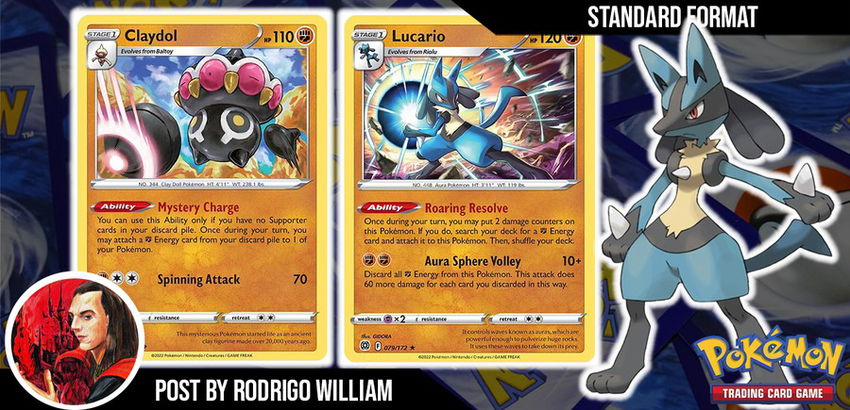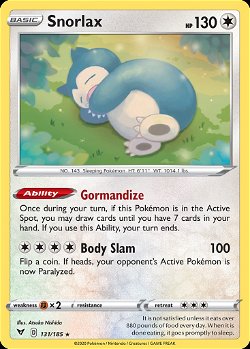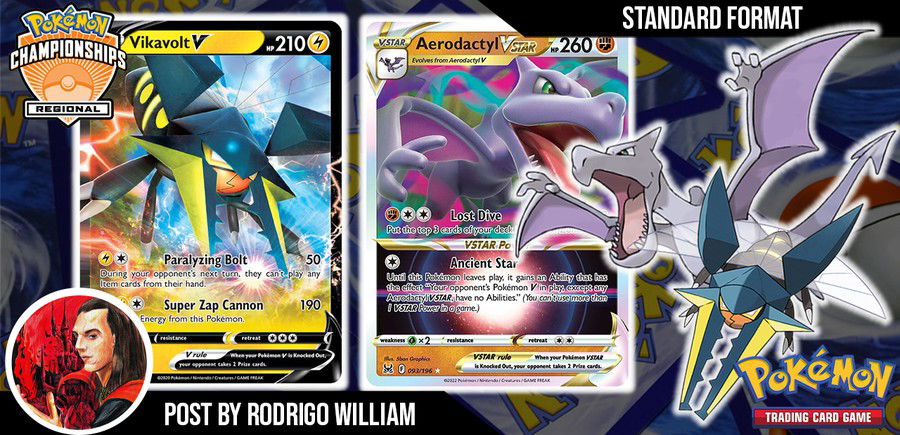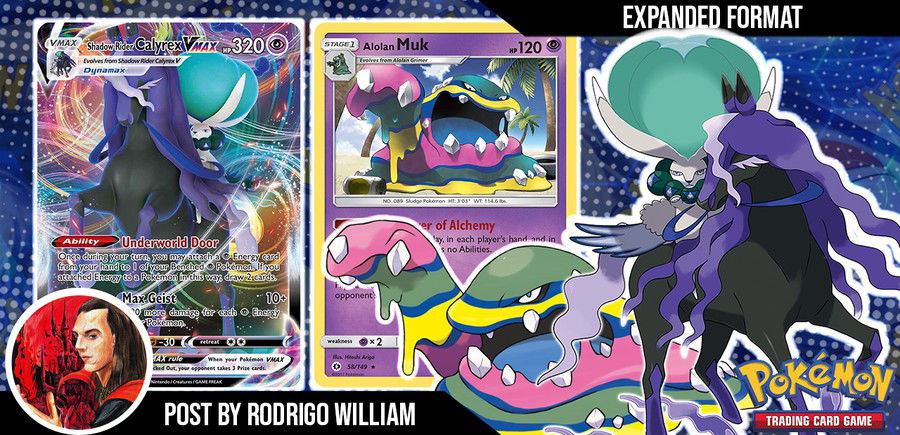Today, I'll bring a cheap Lucario (from Sword/Shield: Brilliant Stars) and Claydol (from Sword/Shield: Silver Tempest) deck based on Lucario's aggression to hoard energies to deal damage and the most unusual part: without using any Supporter card in the deck.
Besides that, it is a fun deck for the Standard format. It's worth stressing this deck's building credits go to Popsicle Knight.
So, let's analyze the deck and understand how it works.
Lucario + Claydol
Decklist
Ad
Lucario: Main Attacker

1) Ability - Roaring Resolve: during your turn, you can look for two fighting type energies in your deck to attach to this Pokémon. If you do, you put 2 damage counters in this Pokémon. After that, shuffle your deck.
2) Attack - Aura Sphere Volley (F)(F): discard all fighting energies attached to this Pokémon. This attack deals 10 + 60 for each energy discarded this way.
What does that remind us of? Lucario BRS 79's ability is the same as Charizard TEU 14's from Sun/Moon: Team Up.
With that, the play lines are simple: charge up the maximum number of energies in one turn, with fighting energies going to Lucario BRS 79 to deal more damage.
Suppose in a play in which you use this ability to get two energies, plus the use of Claydol SIT 94's ability to get one fighting energy from the discard pile plus one turn energy from your hand, it's practically 4 energies to deal an attack of 240 damage plus the 10 base damage, dealing 250 damage in one turn alone!
Claydol: Energy Charging Recursive Pokémon

What interests us here is precisely the use of its ability, as there aren't any Supporter cards in the deck, which makes it easier to charge Lucario BRS 79.
Recursive Pokémon

- Miltank ASR 126 comes in with Miracle Body, with which this Pokémon doesn't take damage from V type Pokémon (that is, V, VStar, VMax or VUnion).
- Snorlax VIV 131 has the ability Gormandize, which makes you draw until you have 7 cards in your hand, and if you do, your turn ends.
- Manaphy BRS 41 has Wave Veil, which makes it protect your benched Pokémon from enemy "Sniper" Pokémon attacks.
- Bibarel BRS 121 has Industrious Incisors which makes you draw until you have 5 cards in your hand.
Trainer Cards

- Scoop Up Net RCL 165 is useful to retrieve a Pokémon in play to your hand as long as it isn't GX or V, this way "looping" a Pokémon's retreat in particular, such as Snorlax, after it has fulfilled its card draw role.
- Trekking Shoes ASR 156 makes you look at the top card in your deck and choose between:
1) taking the card to yourself;
2) or discarding the card and right afterward getting the next one on top.
- Ultra Ball BRS 150 is useful to look for any Pokémon in your deck, as long as you discard two cards from your hand.
- Level Ball BST 129 is useful to look for any Pokémon in your deck, as long as it has 90 HP or less, and place it in your hand.

- Gutsy Pickaxe ASR 145 is useful to look for any fighting type energy. It makes you look at the top card in your deck and has the following requirements: if this card on top is a fighting energy card, you can attach it to one of your benched Pokémon; if not, and the top card isn't an energy, it will remain in your hand.
Ad
- Ordinary Rod SSH 171 is useful to get this recycle effect, choosing one of the two following options or both:
1) Look for two Pokémon in the discard pile and place them in your deck.
2) Look for two basic energies in the discard pile and place them in your deck.
- Choice Belt BRS 135 is useful as a damage booster against any V Pokémon, granting 30 damage more to the Pokémon to which this Tool is equipped.
- Big Parasol DAA 157, when equipped to a Pokémon, prevents damage from the enemy's Active Pokémon attacks (previously existing effects are not removed and damage isn't considered an effect).
- Air Balloon SSH 156 helps with return mobility and flexibility.
Stadiums

- Training Court RCL 169 is useful to get a basic energy card from the discard pile and place it in your hand (this serves to you and your opponent).
- PokéStop PGO 68 is useful to discard the top 3 cards in your deck. If these discarded cards are Item cards, you can get all of them and place it in your hand, and the rest that are not Item cards, will be discarded (this serves to you and your opponent).
Format's Archetypes
Advantages
It is a cheap and practical deck to build, and is quite constant with actions because there is an absence of Supporter cards, the use of Item Trainer cards are constant, and this way, it can do combos and have dynamic attacks in just a few turns, and of course, it hits the electric type weakness, such as Regieleki VMAX SIT 58, Tapu Koko VMAX BST 51, Boltund VMAX FST 104, Jolteon VMAX PR-SW SWSH184 and others of this archetype.
Disadvantages
As it is a “Rogue” cards deck (term used for cards in decks with "baby" Pokémon mostly and which don't have the same destruction power as the format's Ultra Rare cards), it wouldn't reach the Top "Tier" of decks such as Lugia VStar, Mew VMax, Duraludon VMax, Regidrago VStar, Giratina VStar, Mewtwo VUnion, Origin Form Palkia VStar and the like.
It was made to deal with Single Prize decks, and can occasionally wreak havoc for certain big Pokémon such as a VStar or a VMax, but as said before, it would hardly go into the Top 3 of a "Top Tier" list.
Final Thoughts
It is a Single Prize deck which is quite didactic to pilot and has an "ABCD" line in the most simple sense of using Lucario to get energies from the deck and Claydol from the discard pile to get one more energy and deal damage.
Now it's your turn: what did you think of the deck? You're welcome to comment down below!
See you in the next article.










— Commenti0
Diventa il primo a commentare